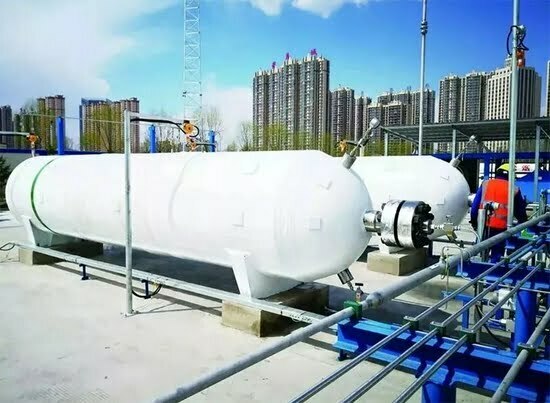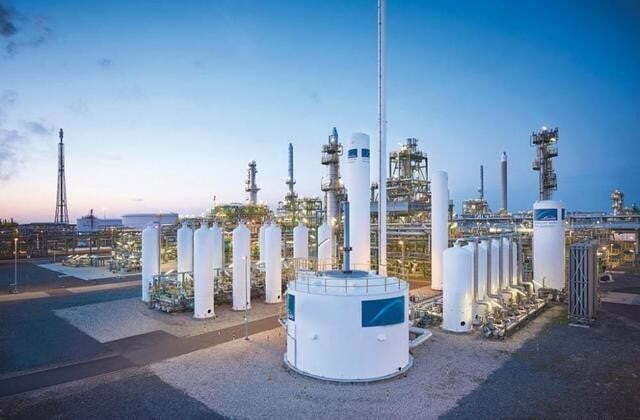At present, there are four main paths for global hydrogen storage: High-pressure gaseous hydrogen storage technology, low-temperature liquid hydrogen storage technology, solid-state hydrogen storage technology and organic liquid hydrogen storage technology
The mainstream of development in China’s hydrogen storage industry is high-pressure gaseous hydrogen storage, and most hydrogen refueling stations use high-pressure hydrogen storage.
High-pressure gaseous hydrogen storage
| Technology | At high temperatures, the hydrogen is compressed and stored in a high-density gaseous form |
| Advantage | Lower cost; Mature technology; Low energy consumption; Shorter hydrogen charging and discharging time; |
| Defect | Low volumetric hydrogen storage density; The volume is smaller than the capacity; Safety hazards of leakage and explosion |
| Technology breakthrough | Further increase the hydrogen storage pressure and hydrogen storage mass density of hydrogen storage tanks; Improve the material of the hydrogen storage tank; |
| Application | The most mature and commonly used technology is currently the most mature and the most commonly used technology for automotive hydrogen storage |

Low temperature liquid hydrogen storage
| Technology | Using hydrogen to liquefy under high pressure and low temperature conditions, the volume density is 845 times that of gaseous state, and its transmission efficiency is higher than that of gaseous hydrogen |
| Advantage | High volumetric hydrogen storage density; High purity of liquid hydrogen |
| Defect | The liquefaction process consumes a lot of energy; volatile; high cost |
| Technology breakthrough | In order to improve the heat preservation efficiency, it is necessary to add heat preservation layer or moisturizing equipment to overcome the contradiction between heat preservation and hydrogen storage density; Reduce the loss of about 1% caused by hydrogen gasification during hydrogen storage; Reduce the energy consumed by the heat preservation process, which is equivalent to 30% of the mass energy of liquid hydrogen |
| Application | Mainly used in the aerospace field, suitable for ultra-high-power commercial vehicles |

Solid state hydrogen storage
| Technology | Using the physical adsorption or chemical reaction of the solid to hydrogen, the hydrogen is stored in the solid material without pressure and freezing |
| Advantage | High volumetric hydrogen storage density; Safe and convenient operation; No need for high pressure vessel; With purification function; High purity hydrogen obtained |
| Defect | Low mass hydrogen storage density high cost; There are temperature requirements when absorbing and discharging hydrogen; Poor resistance to impurity gases |
| Technology breakthrough | Improve quality hydrogen storage density; reduce cost and temperature requirements |
| Application | Important development direction in the future |
Organic liquid hydrogen storage
| Technology | Based on the hydrogenation reaction of the unsaturated liquid organic matter under the action of the catalyst to generate stable compounds, and then the dehydrogenation reaction when hydrogen is needed |
| Advantage | High hydrogen storage density; Recycling of organic liquids can be realized through hydrogenation and dehydrogenation processes; The cost is relatively low; Higher security; |
| Defect | The purity of hydrogen is not high, there is a possibility of side effects and impurity gas; Higher cost, corresponding device must be equipped |
| Technology breakthrough | Improve the dehydrogenation rate and efficiency of the organic liquid hydrogen storage medium at low temperature, and the reaction performance of the catalyst; Improve reaction conditions, reduce dehydrogenation cost and operation difficulty |
| Application | Can use traditional petroleum facilities for transportation and bunkering |

Looking at the domestic hydrogen storage market, high-pressure hydrogen storage technology is relatively mature and has obvious advantages. It will be the main domestic hydrogen storage technology for a certain period of time. However, due to the potential safety hazards of high pressure and the low volume-to-volume ratio, the application of hydrogen fuel vehicles is not perfect, and it can be speculated that future applications will be relatively reduced.
Low-temperature liquid hydrogen storage technology is still in the stage of serving only aerospace and aviation in my country, and it is unlikely that it will be applied to the private sector in the short term. Low-temperature liquid hydrogen storage technology is costly. In the long run, its commercial application prospects in China are not as good as other hydrogen storage technologies.
The application of solid-state hydrogen storage in fuel cell vehicles has obvious advantages, but there are still technical difficulties. In the short term, there should not be a wide range of applications, but in the long term, the development potential is relatively large.
Organic liquid hydrogen storage technology can use traditional petroleum infrastructure for transportation and refueling, and it is convenient to build a hydrogenation network like a gas station. Compared with other technologies, it has unique safety and transportation convenience. However, this technology still has many technical problems, and it will have great application prospects in the future.